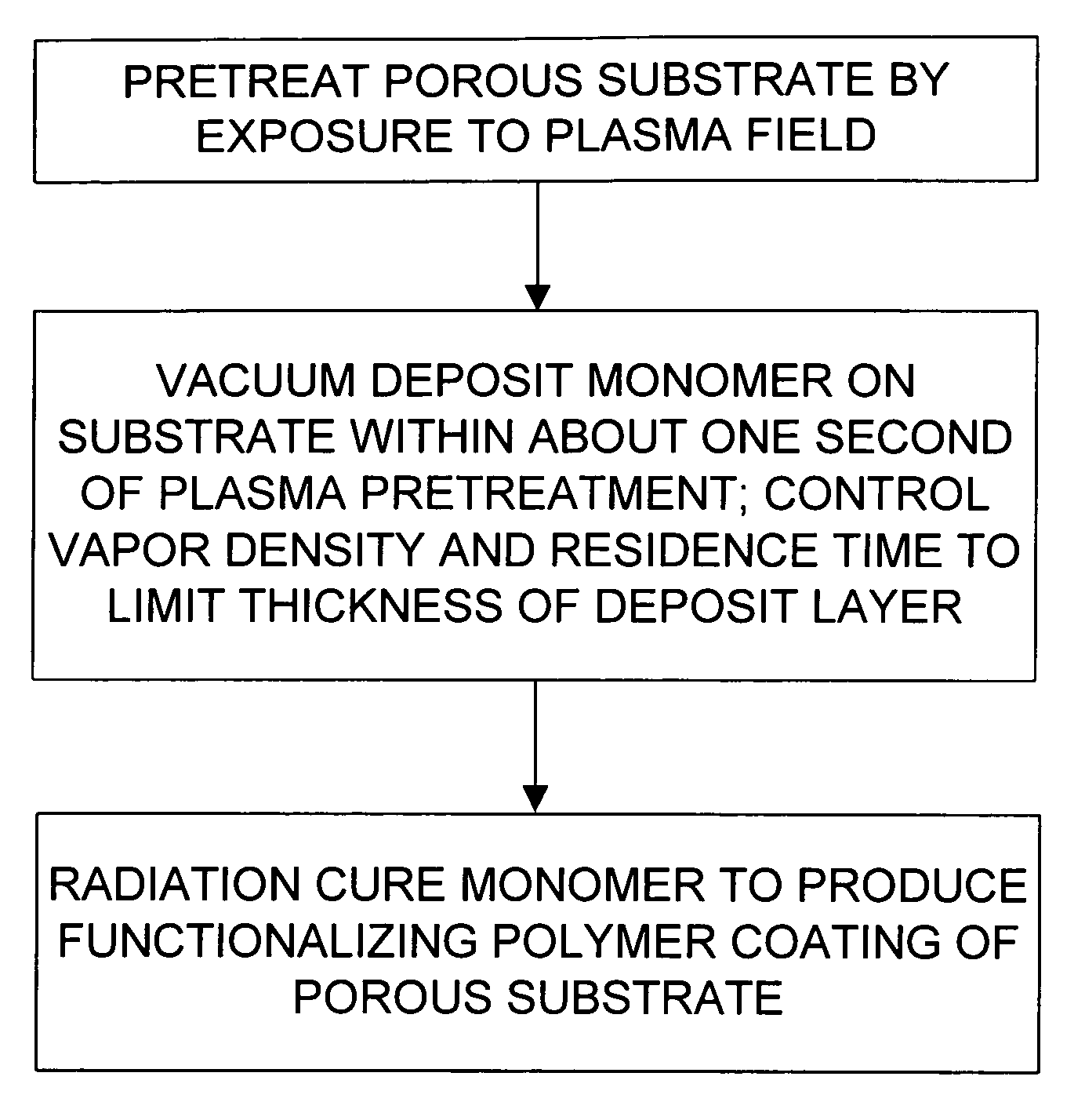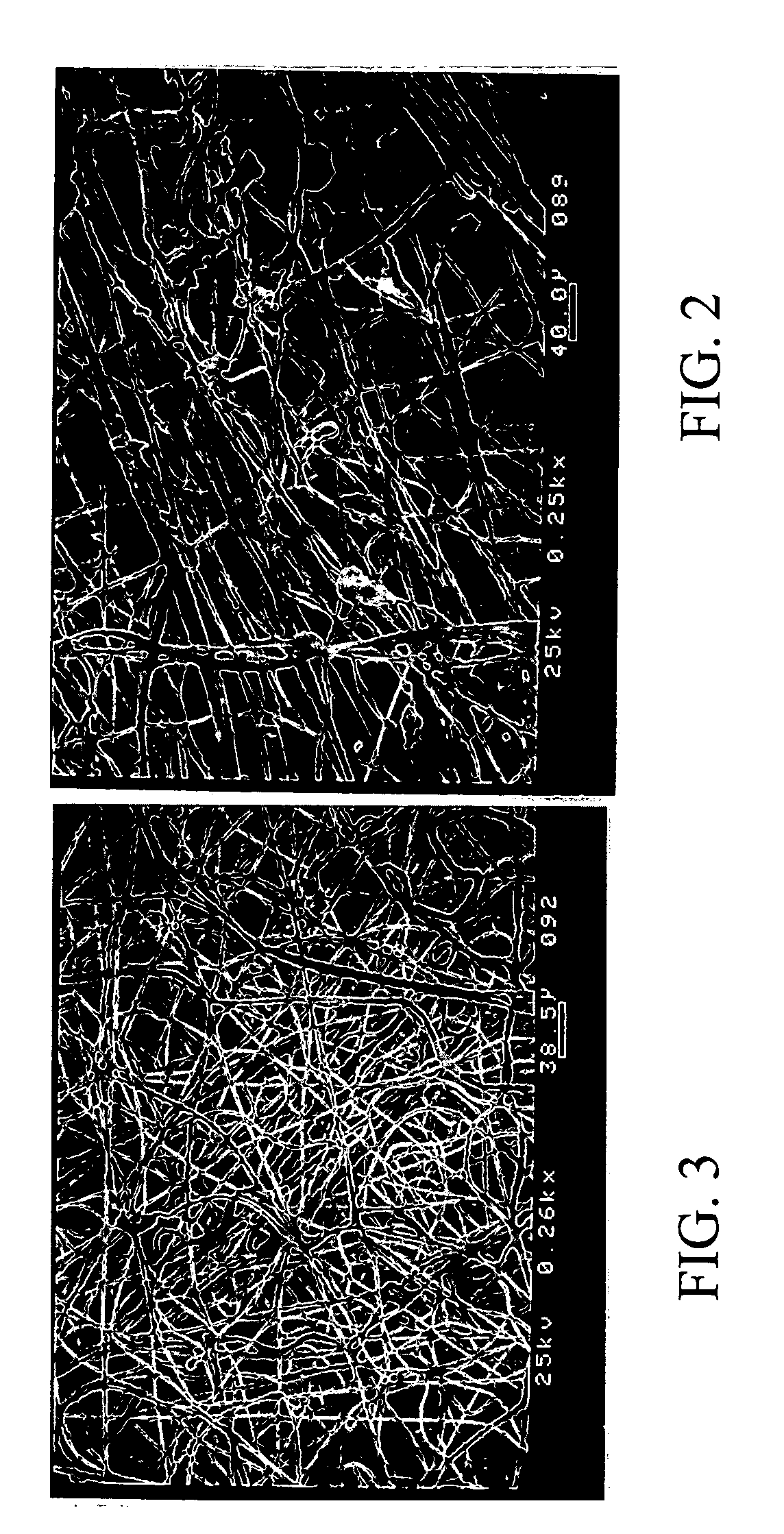Functionalization of porous materials by vacuum deposition of polymers
a technology of polymerization and porous materials, applied in the field of material surface functionalization, can solve the problems of low durability, poor resistance to abrasion, and essentially unaffected porous substrate, and achieve the effects of low durability, poor resistance to abrasion, and increased reflectivity
- Summary
- Abstract
- Description
- Claims
- Application Information
AI Technical Summary
Benefits of technology
Problems solved by technology
Method used
Image
Examples
example 1
Hydrophobic / Oleophobic Coating
[0041]A melt-blown polypropylene nonwoven fabric was functionalized with a hydrophobic / oleophobic fluorinated acrylate polymer coating to create a repellent surface. The monomer was flash evaporated at about 100 Millitorr. The fabric was pretreated in a plasma field and within one second it was exposed to the monomer vapor for condensation while traveling at a speed of about 50 meters / minute. The condensed monomer layer was cured in-line by electron beam radiation within 100 milliseconds. A polymer coating thickness of about 0.1 μm resulted from the run, which was found to provide adequate repellency for water and oil with a surface energy of about 27 dyne / cm. The functionalized fabric repelled both water-based and oil-based fluids while substantially retaining the original permeability of the fabric. The coated materials showed high performance as electrostatic charged filter media. The same coating process with the same fluoro-acrylate monomer was rep...
example 2
[0043]A melt-blown polypropylene nonwoven fabric was coated with a hydrophilic acrylate polymer film functionalized with hydroxyl, carboxyl, sulfonic, amino, amido and ether groups (in separate tests) to create a water absorbent surface. The monomer was flash evaporated at about 10 Millitorr. The fabric was pretreated in a plasma field and within one second it was exposed to the monomer vapor for condensation while traveling at a speed of about 30 meters / minute. The condensed monomer layer was cured in-line by electron beam radiation within 150 milliseconds. A polymer coating thickness of about 0.1 μm resulted from the run, which was found to provide adequate wettability in all cases by water with a surface energy of about 70–72 dyne / cm. The functionalized fabrics absorbed water while substantially retaining the original permeability of the fabrics. The coated materials showed high performance as water absorbent media. The same coating process with the same hydrop...
example 3
Hydrophobic / Oleophobic Colored Coating
[0045]The same experiment as in Example 1 was repeated with 3–5% organic dyes (e.g., disperse red) mixed in the fluorinated acrylate monomer. The coated substrates showed the same levels of water and oil repellency, measured at about 6 and 5 on the Dupont® Teflon® Repellency Test, respectively, with the color added to the coating. The intensity of the color can be controlled by monitoring either the amount of organic dye or the thickness of the coating.
PUM
| Property | Measurement | Unit |
|---|---|---|
| thickness | aaaaa | aaaaa |
| thickness | aaaaa | aaaaa |
| thick | aaaaa | aaaaa |
Abstract
Description
Claims
Application Information
 Login to View More
Login to View More - R&D
- Intellectual Property
- Life Sciences
- Materials
- Tech Scout
- Unparalleled Data Quality
- Higher Quality Content
- 60% Fewer Hallucinations
Browse by: Latest US Patents, China's latest patents, Technical Efficacy Thesaurus, Application Domain, Technology Topic, Popular Technical Reports.
© 2025 PatSnap. All rights reserved.Legal|Privacy policy|Modern Slavery Act Transparency Statement|Sitemap|About US| Contact US: help@patsnap.com



